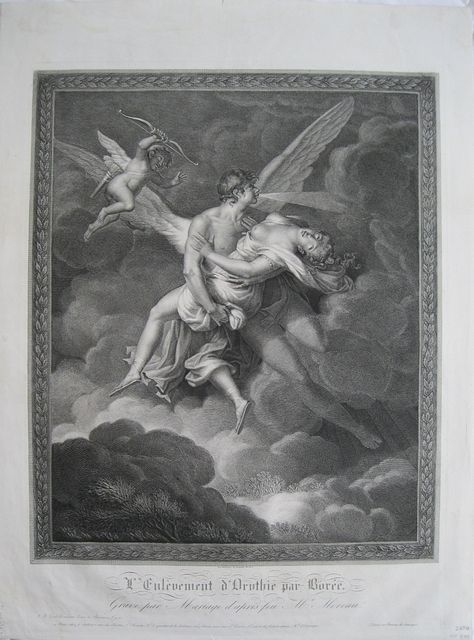
MAPS & VIEWS
PRINTS
BOOKS
back to search results place the mouse over an image to zoom
The Abduction of Oreithyia.
Moreau, Jean Michel, le Jeune, The Abduction of Oreithyia by Boreas. "L'Enlèvement d'Orythie par Borée." Paris "chez l'Auteur, rue de Cloitre St. Benoit No 8.." c.1770Large copper engraved depiction of the abduction of Oreithyia by Jean Michel Moreau, la Jeune. Black and white, verso blank.
One of a suite of 2 prints by the prolific engraver Moreau le Jeune, (the other depicting Pygmaleon.} The image shows the winged Borreas carrying Oreithyia in his arms, into the clouds with Eros looking on. Surrounded by an engraved border.
OREITHYIA was was a mountain Nymph, daughter of Erechtheus and Praxithea, abducted by boreas, the north wind, WHEN SHE STRAYED beyond the river ilissus, NEAR aTHENS. HE CARRIED HER BACK TO Mount Haemus in ThraCe WHERE SHE BECAME HIS IMMORTAL WIFE AND GODDESS OF CHILL MOUNTAIN WINDS. ONE OF THEIR DAUGHTERS WAS kHIONE (SNOW).
Pausanias, Description of Greece 3. 15. 2 :
"While Orithyia was playing by the ILissos river, Boreas carried her off and had intercourse with her; and she bore daughters, Kleopatra and Khione, and winged sons, Zetes and Kalais." Dark impression; clean and bright.
Jean Michel Moreau, le Jeune 1741-1814.
was a French draughtsman, illustrator and engraver. He was the pupil of the painter Louis-Joseph Le Lorrain who accompanied his master to St Petersburg in 1758 when Le Lorrain went to be the first director of the Saint Petersburg Academy of Fine Arts established the previous year, where Moreau briefly taught drawing before returning to Paris in 1759, after Le Lorrain's unexpected death.
He worked for the engraver Jacques-Philippe Lebas, producing reproductive drawings of contemporary paintings and those of Old Masters for engravers to work from and learning etching During the 1760s he also provided drawings to be engraved for the Recueil d'antiquitésof the Comte de Caylus;he also worked for Diderot and Alembert's Encyclopédieand collaborated with François Boucher, Hubert Gravelot and others on illustrations for an edition of Ovid's Metamorphoses.
In 1770 he succeeded Charles-Nicolas Cochin as chief Dessinateur des Menus Plaisirs du Roi,on Cochin's recommendation, which occasioned his prints celebrating the marriage of the Dauphin and his coronation as Louis XVI; in 1781, in part on the strength of these productions he was appointed Dessinateur et Graveur du Cabinet du Roi,which brought an annual pension and lodgings in the galleries of the Palais du Louvre.
He thence became so busy he found that he required the services of other engravers to reproduce his own designs, which included illustrations for the Chansons of Jean Benjamin de Laborde (1773), the collected works of Rousseau (1773–82) and of Voltaire (printed at Brussels, 1782–9).
The French Revolution, with which Moreau was in sympathy, did not hinder his success as an illustrator, providing engravers with pen and wash drawings to replicate, as for a French translation of the Aeneid published in 1804 In 1793 Moreau was appointed to the CommissionTemporaire des Artsand in 1797 was made a professor at the newly reformed écoles centrales. With the Bourbon restoration in 1814 Louis XVIII appointed him once again to a royal office.
In his prolific career his best-known works are those twenty-four illustrations that record fashionable dress and interiors of the last years of the Ancien Régime, his contributions to the Monument du costume physique et morale, twelve as a Suite d'estampes pour servir à l'histoire dews mœurs des François au dix-huitième siècle, 1776 and 1777, and twelve more in the Troisième Suite d'éstampes pour servir a l'Histoire des Moeurs et du Costume..., 1783, published by his uncle by marriage, L.-F. Prault, and many times re-issued in varying formats, notably in a collection in 1789 with text by Restif de la Bretonne.
He also contributed engravings of costumes and decorative vignettes to Choiseul-Gouffier's Voyage pittoresque de la Grèce1782.
Bocher;p79; no 205 575 by 420mm (22¾ by 16½ inches). ref: 2676 €850
Company: Bryan, Mary Louise.
Address: Ag. Andrianoy 92 , 21 100 Nafplio, Greece.
Vat No: EL 119092581

